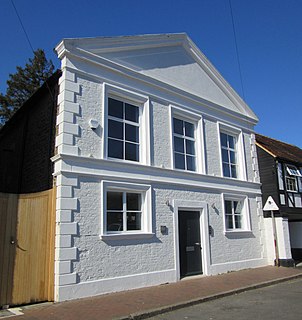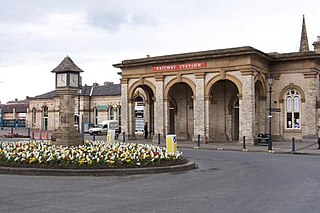
Bridlington is a coastal town and civil parish on the Holderness Coast of the North Sea, situated in the unitary authority and ceremonial county of the East Riding of Yorkshire approximately 28 miles (45 km) north of Hull and 34 miles (55 km) east of York. The Gypsey Race river runs through the town and emerges into the North Sea in the town harbour. In the 2011 Census the population of the parish was 35,369.

Driffield, also known as Great Driffield, is a market town and civil parish in the East Riding of Yorkshire, England. The civil parish is formed by the town of Driffield and the village of Little Driffield. By road, it is 70 miles (110 km) north-east of Sheffield, 29 miles (47 km) east of York, 23 miles (37 km) north of Hull, 72 miles (116 km) south-east of Middlesbrough, and 218 miles (351 km) north of London.

Horbury is a town in the City of Wakefield, a metropolitan district of West Yorkshire, England and part of the West Yorkshire Urban Area. Historically in the West Riding of Yorkshire, it is situated north of the River Calder about three miles (5 km) south west of Wakefield and two miles (3 km) to the south of Ossett. It includes the outlying areas of Horbury Bridge and Horbury Junction. At the 2001 census the Horbury and South Ossett ward of Wakefield Metropolitan District Council had a population of 10,002. At the 2011 census the population was 15,032. Old industries include woollens, engineering and building wagons for the railways but the area is now largely residential and retail.

See Francis Johnston (architect) for Irish architect with a similar name.

Aiskew is a village in the civil parish of Aiskew and Leeming Bar, in the Hambleton District of North Yorkshire, England. The village is situated to the immediate north-east of Bedale and separated from it by Bedale Beck.

Quarry Hill is an area of central Leeds, West Yorkshire, England. It is bounded by the Leeds Inner Ring Road in the east and north and the Leeds – York / Hull railway in the south. The area falls within the City and Hunslet ward of Leeds City Council.

Richmond Hill is a district of Leeds, West Yorkshire, England. The district lies a mile to the east of the city centre between York Road, East End Park and Cross Green. The appropriate City of Leeds ward is Burmantofts and Richmond Hill.

George Gaze Pace, was an English architect who specialised in ecclesiastical works.

Idle is a residential suburban area in the city of Bradford, West Yorkshire, in England and was a separate village and before that the Manor of Idle. Idle is loosely bordered by the areas of Eccleshill, Wrose, Thackley, Apperley Bridge, and Greengates, in the north-east of the city.
William Hill was an English architect who practised from offices in Leeds, West Yorkshire, England.

Burnley, in Lancashire, England, has a long history of religious worship, dating from at least before 1122 in the case of the Church of England. The chapel at Towneley Hall was the centre for Roman Catholic worship in Burnley until modern times. Well before the Industrial Revolution, the town saw the emergence of many non-conformist churches and chapels. In 1891 the town was the location of the meeting which saw the creation of the Baptist Union of Great Britain and Ireland. In the late 19th century a Jewish synagogue was established, and in recent times evangelical and free churches have appeared, as well as a large purpose-built mosque.
John Wills was an architect based in Derby.

The former Salvation Army Hall in Godalming, Surrey, England, now an office building known as Aurum House, has been used by three religious groups since its construction c. 1830. The ancient town in the English county of Surrey has a long and diverse history of Protestant Nonconformity, and three Nonconformst denominations are represented: at first it served Congregationalists, but when they built a larger chapel in the town it passed to the Methodist Church. In the 20th century it was occupied by The Salvation Army, but it closed in 2012 and was redeveloped for commercial use. The building has been listed at Grade II for its architectural and historical importance.

William Peachey was an architect known for his work for the North Eastern Railway.

The Rotunda was a Primitive Methodist church in Aldershot in Hampshire in the UK that was completed in 1876 and demolished in the 1980s. The building took its name from the architectural form rotunda and was notable as one of only 14 octagonal churches built by the Methodist Church.

George Woodhouse was an English architect who practised from offices in Bolton, and Oldham, then in the county of Lancashire. He collaborated with William Hill on the designs for Bolton Town Hall.

William James Morley FRIBA was an English architect who practised from offices in Bolton, Greater Manchester and Bradford, West Yorkshire
Alfred Hill Thompson, ARIBA was an English architect in the Gothic Revival and Arts and Crafts styles, who specialised in small schools and chapels in the Yorkshire area. In partnership with Isaac Thomas Shutt he co-designed the Church of All Saints, Harlow Hill, completed in 1871.



















